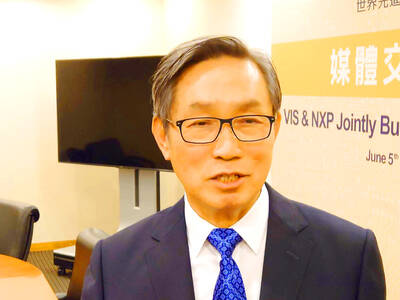Largan Precision Co (大立光), the nation's leading maker of camera lenses, yesterday posted record high gross margins, thanks to strong shipments of camera-phone lenses.
Margins in the second quarter hit new highs of 61.2 percent, compared to 40 percent in the same period last year, and 61 percent in the first quarter, the company told investors yesterday.
Net income in the second quarter was NT$794.6 million (US$22.9 million), or NT$6.93 per share, up 386 percent from last year's NT$163.6 million, or NT$1.43 per share, it said.
"The third quarter will be better than the second, as our orders have been lining up till November," said chairman and chief executive Scott Lin (
While the results did not surprise analysts, Vincent Chen (
The Taichung-based Largan -- which supplies optical lenses for camera phones, digital still cameras and multifunctional printers -- will venture into two new businesses next year, according to Lin.
He said that it will move into a totally new segment, which is just taking off and "full of potential," as well as focusing on a second segment that already exists, but in which the company says it has "better technology."
Lin refused to elaborate.
However, he said the company's long-term strategy is to diversify risks on camera handsets, whose growth momentum will continue over the next three years.
His comments raised curiosity among analysts, with one, who asked not to be named, speculating that the company must be getting ready to set a new milestone, as Lin would normally not disclose any details unless he is fully ready.
For the first six months of the year, mobile-phone lenses accounted for 78 percent of Largan's total revenues, while 11 percent were generated by digital cameras, the company's data showed.
Multi-functional printers made up 7 percent, while projectors took 1 percent, it said.
Meanwhile, Lin said that the company's shipments of one-megapixel camera-phone lenses have surpassed lower-resolution video-graphics-array (VGA) lenses to over 50 percent, while two-megapixel lenses are gaining momentum.
One and two-megapixel lenses will be the mainstream resolutions used in the handset industry, while three megapixel lenses will start to gain ground in fourth quarter next year at the earliest, he said.
However, "VGA lenses will still play a part in our shipments, as cameras become standard on low-end phones," he said.
Largan's shares closed down 1.25 percent to NT$709 yesterday on the Taiwan Stock Exchange.

STEEP DECLINE: Yesterday’s drop was the third-steepest in its history, the steepest being Monday’s drop in the wake of the tariff announcement on Wednesday last week Taiwanese stocks continued their heavy sell-off yesterday, as concerns over US tariffs and unwinding of leveraged bets weighed on the market. The benchmark TAIEX plunged 1,068.19 points, or 5.79 percent, to 17,391.76, notching the biggest drop among Asian peers as it hit a 15-month low. The decline came even after the government on late Tuesday authorized the NT$500 billion (US$15.2 billion) National Stabilization Fund (國安基金) to step in to buoy the market amid investors’ worries over tariffs imposed by US President Donald Trump. Yesterday’s decline was the third-steepest in its history, trailing only the declines of 2,065.87 points on Monday and

TAKING STOCK: A Taiwanese cookware firm in Vietnam urged customers to assess inventory or place orders early so shipments can reach the US while tariffs are paused Taiwanese businesses in Vietnam are exploring alternatives after the White House imposed a 46 percent import duty on Vietnamese goods, following US President Donald Trump’s announcement of “reciprocal” tariffs on the US’ trading partners. Lo Shih-liang (羅世良), chairman of Brico Industry Co (裕茂工業), a Taiwanese company that manufactures cast iron cookware and stove components in Vietnam, said that more than 40 percent of his business was tied to the US market, describing the constant US policy shifts as an emotional roller coaster. “I work during the day and stay up all night watching the news. I’ve been following US news until 3am

Six years ago, LVMH’s billionaire CEO Bernard Arnault and US President Donald Trump cut the blue ribbon on a factory in rural Texas that would make designer handbags for Louis Vuitton, one of the world’s best-known luxury brands. However, since the high-profile opening, the factory has faced a host of problems limiting production, 11 former Louis Vuitton employees said. The site has consistently ranked among the worst-performing for Louis Vuitton globally, “significantly” underperforming other facilities, said three former Louis Vuitton workers and a senior industry source, who cited internal rankings shared with staff. The plant’s problems — which have not

TARIFF CONCERNS: The chipmaker cited global uncertainty from US tariffs and a weakening economic outlook, but said its Singapore expansion remains on track Vanguard International Semiconductor Corp (世界先進), a foundry service provider specializing in producing power management and display driver chips, yesterday withdrew its full-year revenue projection of moderate growth for this year, as escalating US tariff tensions raised uncertainty and concern about a potential economic recession. The Hsinchu-based chipmaker in February said revenues this year would grow mildly from last year based on improving supply chain inventory levels and market demand. At the time, it also anticipated gradual quarter revenue growth. However, the US’ sweeping tariff policy has upended the industry’s supply chains and weakened economic prospects for the world economy, it said. “Now